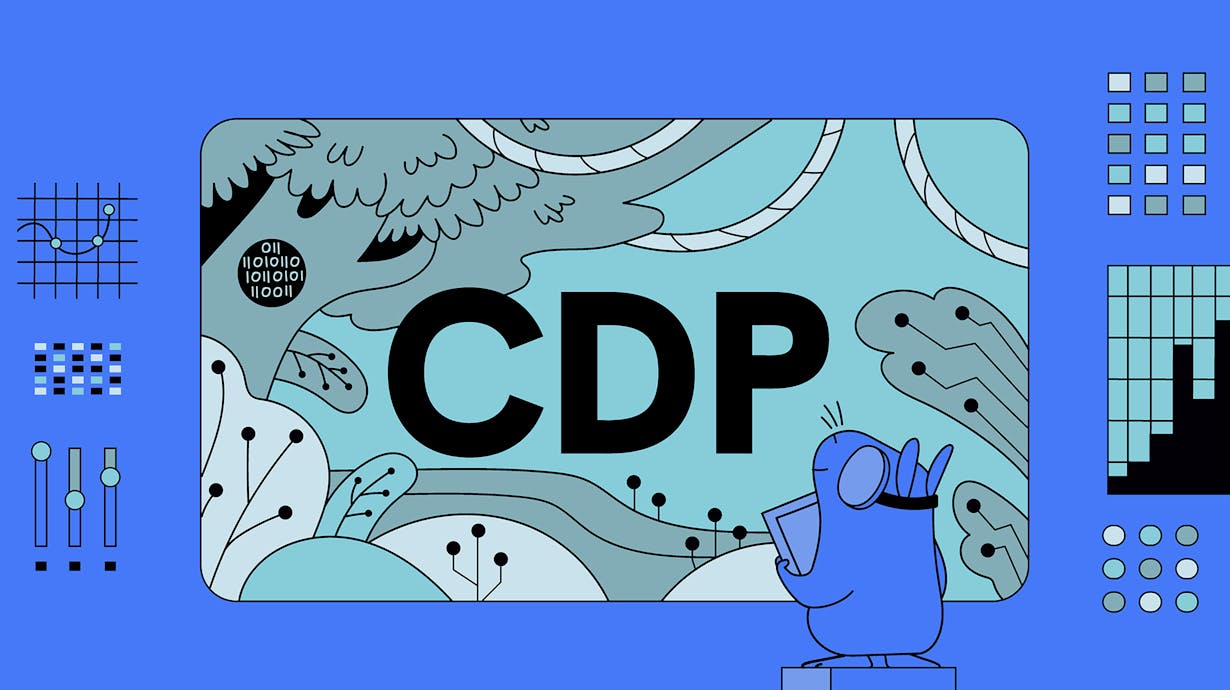What is a Customer Data Platform?
Learn more about what a Customer Data Platform (CDP) is and how you can make sense of the rapidly evolving Customer Data Platform market.

In the past few years, several market shifts have led teams to rethink the way that they use customer data. New legislations, such as GDPR and CCPA/CPRA, have increased the importance of investing in data privacy and managing user consent. Limitations in third-party cookie tracking have forced teams to invest in building their own first-party data set. Increased ad prices on platforms such as Facebook and Google have made customer acquisition more expensive, leading brands to shift their focus to retention.
At the same time, the extreme increase in SaaS tools available across marketing automation, product analytics, customer service, and advertising has inspired teams to move away from legacy cloud offerings and build a best-in-class tech stack.
Although these changes may seem to affect the organization in disparate ways, the reality is that they are all tied to a common need: The ability to access first-party customer data and integrate it across systems in real time while managing data quality and data privacy. And the opposite method–maintaining fragmented customer data sets in DMPs, CRMs, and data warehouses, and "stitching" it all together with MDM or ETL solutions (or worse, manually)–is now the primary factor preventing teams from adapting to the current market environment.
Customer Data Platforms (CDPs) have become highly sought after by Marketers, Product Managers, Data Engineers, and Data Scientists due to their ability to simplify the customer data pipeline, improve access to customer data, and power better data-driven experiences. That said, the rapid evolution of the CDP market has led to some confusion of what exactly a CDP is.
What is a Customer Data Platform?
A Customer Data Platform (CDP) is a software application that supports marketing, product analytics, and customer experience use cases by unifying a company’s customer data from multiple data sources and making it available to additional systems. CDPs make it easier for teams to access customer data and use it to optimize the timing and targeting of messages, offers, and customer engagement activities, power individual-level personalization, and to support analysis of customer behavior.
There are five key functions of a CDP:
- Data collection: The ability to ingest first-party, individual-level customer data from multiple sources via packaged API connections and SDKs, and store that data in a usable format.
- Data governance: The ability to granularly enforce which events gets passed onto each system, and process data subject requests - access, portability, erasure
- Data quality protection and profile unification: The ability to monitor data accuracy, consistency, deduplication, and structure, and to unify events and attributes to persistent profiles at the individual-level as data is collected
- Segmentation: An interface that enables business users to build and manage audience segments
- Data integration and activation: The ability to send audience segments and forward events to external tools and systems through pre-built integrations, as well as to orchestrate contextual customer experiences across channels
With a diverse market including 130+ vendors, however, it’s worth noting that not all providers support these functions to the same degree. To make sense of the market, it’s helpful to break the Customer Data Platform market into four categories.
What are the different types of Customer Data Platforms?
According to the CDP Institute, there are currently well over 120 different companies that offer CDP solutions. Sorting through the noise of the CDP market has been difficult for even the most industry-savvy teams. That said, several distinct categories of CDPs have begun to emerge: Customer data infrastructure, marketing cloud offerings, application-layer marketing hubs, and CDP tool kits. While categories can share some overlapping capabilities - identity resolution, segmentation, API integrations - the deployment choice between them is significant.
Customer data infrastructure
As companies’ tech stacks evolve at an increasing rate, the ability to access consistent, high-quality data across tools while also supporting data privacy is critical. Customer data infrastructure helps teams move data freely and securely between systems and applications in real time while also managing data quality and protecting consumer privacy.
Using embeddable SDKs and APIs, infrastructure-layer CDPs collect first-party customer data from multiple customer touch points (Mobile, Web, OTT, POS systems, and more). Data is then cleansed and linked to individual customer profiles before it’s sent downstream to advertising, marketing, operational and analytics systems. While adoption of customer data infrastructure requires initial investment from engineering teams, they provide self-serve data routing capabilities to non-technical teams, such as Product, Marketing, Analytics, and Customer Support post-implementation. Included in these capabilities is the ability to leverage predictive insights to create audience segments. Once built, audience segments can be connected to marketing engagement tools for personalized campaigns. This functionality saves thousands of development hours in the long run.
| Strengths | Current limitations |
|---|---|
| Data collection Data governance Data quality protection and profile unification Segmentation Data integration and activation |
Machine Learning |
Marketing clouds
Several of the large multi-suite cloud companies have announced CDP solutions. One of the major drivers for CDP interest has been the inflexibility and disparate nature of marketing cloud suites historically. The cloud offerings aim to introduce a CDP module as part of an integrated suite that facilitates profile unification, segmentation, and data activation. These products typically limit data sources and destinations to the cloud’s suite of products, however, promoting vendor lock-in and reducing adaptability over time.
| Strengths | Current limitations |
|---|---|
| Segmentation Activation |
Data collection Data governance Data quality protection and profile unification Data integration |
Smart hubs
Smart hub providers offer data orchestration capabilities that facilitate marketing initiatives, such as offer management and triggered messages, by sending instructions to multiple downstream solutions from within their interface. These vendors provide developed data activation capabilities such as journey mapping, reporting and machine learning, but often do little to help teams optimize event collection, manage customer data quality, and support responsible data governance. Without providing teams with a highly-accurate, secure customer data foundation, it’s questionable how effective data activation use cases can be.
| Strengths | Current limitations |
|---|---|
| Data collection Segmentation Data integration and activation |
Data governance Data quality protection and profile unification |
CDP toolkits and Reverse ETL
A relatively new category of CDP providers, CDP toolkits and Reverse ETL providers enable engineering-led teams to connect customer data residing in their enterprise data warehouse to downstream marketing tools via packaged integrations. These platforms often require SQL knowledge to access data from the data warehouse and therefore are not easily accessible for non-technical stakeholders. They are a good solution for extracting historical data sets that are often stored in the data warehouse, such as, “who watched our show this time last year.” As Reverse ETL platforms’ integrations are often not real-time, however, they are not ideal for supporting use cases such as dynamic personalization, transactional emails, ad suppression, or triggered experiences.
| Strengths | Current limitations |
|---|---|
| Segmentation Data integration and activation |
Data collection Data governance Data quality protection and profile unification |
Why are Customer Data Platforms important today?
Creating a customer data strategy is critical for long-term success, and the path to creating your data strategy is bespoke to your business. Teams often start with a single use case around customer data and don't establish a comprehensive data strategy when they set out to build their digital presence. But this increases risk exposure when market conditions change.
Inside most companies:
- Websites and apps change, with landing pages and app screens being added, optimized, or removed.
- New campaigns are run, often requiring new data flows to measure success. New tools are required to optimize performance, thus requiring new integrations.
- Event tracking changes as developers across different platforms work in silos over time.
- Customers toggle between known and anonymous states, and across different devices, which requires dynamic identity resolution capabilities.
- Users update their consent preferences to opt out of personalized experiences, and their information will need to be extracted from certain flows and tools.
- Models are built and experiments are run which force several of these steps to be repeated.
And in the market:
- New privacy regulations, such as GDPR and CCPA, fundamentally change the way you can collect, manage, and activate data.
- Apple and Google create new platform rules that change how you can access cookies and device identifiers.
- API requirements change as vendors continually update their offerings and specs.
Soon, the challenge evolves from establishing a data strategy to being able to adapt your data strategy to internal and external changes.
Customer Data Platforms provide a data pipeline that can connect customer data to and from internal systems as well as the digital ecosystem, enabling you to address complexity as conditions change.
Further reading
- How is mParticle different from other Customer Data Platforms?
- My data warehouse is my source of truth. Why do I still need a CDP?
- How to prepare for your CDP implementation
- How to build your first-party data strategy
- What's the difference between a CDP and a CRM?
- What's the difference between a CDP and a DMP?
- What's the difference between a CDP and MDM?



